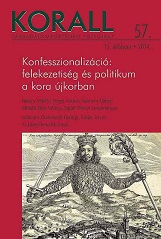Egy kisszebeni plébános tündöklése és bukása. Egyház, állam és helyi közösség konfliktusai a 17. századi Felső-Magyarországon
The Rise and Fall of a Parish Priest in Kisszeben: The Conflicts Between Church, State and Local Community in late 17th-Century Upper Hungary
Author(s): Béla Vilmos MihalikSubject(s): History
Published by: KORALL Társadalomtörténeti Egyesület
Summary/Abstract: One of the most important points of critique against the theory of confessionalisation is that it overemphasizes the role of the state, overestimates the power of the intentions coming from above, and at the same time disregards the interests and resistance capacities of the local communities. This is why Heinz Schilling suggested the application of a “pincers model”, which would analyze how the intentions from below and above cancel out, modify or strengthen each other. I applied this model in a local survey, in which I aimed to show how interactions took place in the triangle between the local society, the representatives of the Catholic church and those of the government. During the 1670s, the so-called “Protestant decade of mourning”, the assumed co-operation between the ecclesiastical, governmental and military spheres was by far not without problems. In December 1675, disregarding the preferences of the local Catholic community in the town of Kisszeben (Sabinov, Slovakia) György Jelencsics, a client of the bishop of Eger was installed as parish priest. The town found an ally in the regional representative of the government, the Szepes Chambers. In the tense situation to follow, Bishop György Bársony placed the town under ecclesiastical interdiction and also threatened the Chambers. The waves raised by this local issue reached as far as to Vienna and Rome. Finally, the Chambers and the bishop reached a compromise and they installed Jelencsics together at the parish in the end of 1676, practically leaving aside the interests of the local Catholic community. Fifteen years later, in 1691, the Catholic community of Kisszeben staged a small scale revolt against the parish priest. He was accused in front of each possible forum because of his affairs with women, financial abuses, and the neglect of his pastoral duties. The case shows that the community internalized the patterns and ways through which he could promote its own interests. Bringing about Jelencsics’s fall the burghers made a skillful use of the procedural practice at the Chambers, as well as the available ecclesiastical fora. At the same time the sources show that they must have been familiar with the fundamental questions of faith and various theological perspectives, which helped them to represent their interests in front of these higher fora.
Journal: Korall - Társadalomtörténeti folyóirat
- Issue Year: 2014
- Issue No: 57
- Page Range: 49-69
- Page Count: 21
- Language: Hungarian

